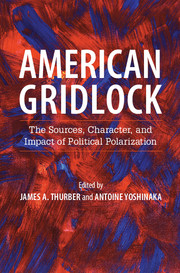Book contents
- Frontmatter
- Dedication
- Contents
- List of contributors
- Foreword
- Acknowledgments
- Introduction
- PART I POLARIZATION AMONG VOTERS AND ACTIVISTS
- 1 The New American Electorate: Partisan, Sorted, and Polarized
- 2 Redistricting and Polarization
- 3 Party Activists, Interest Groups, and Polarization in American Politics
- 4 Authoritarianism and Polarization in American Politics, Still?
- 5 Party Sorting: The Foundations of Polarized Politics
- PART II POLARIZATION IN NATIONAL INSTITUTIONS
- PART III POLARIZATION IN THE STATES
- PART IV POLARIZATION IN THE MEDIA
- PART V IMPLICATIONS AND CONCLUSIONS
- Index
- References
5 - Party Sorting: The Foundations of Polarized Politics
from PART I - POLARIZATION AMONG VOTERS AND ACTIVISTS
Published online by Cambridge University Press: 05 November 2015
- Frontmatter
- Dedication
- Contents
- List of contributors
- Foreword
- Acknowledgments
- Introduction
- PART I POLARIZATION AMONG VOTERS AND ACTIVISTS
- 1 The New American Electorate: Partisan, Sorted, and Polarized
- 2 Redistricting and Polarization
- 3 Party Activists, Interest Groups, and Polarization in American Politics
- 4 Authoritarianism and Polarization in American Politics, Still?
- 5 Party Sorting: The Foundations of Polarized Politics
- PART II POLARIZATION IN NATIONAL INSTITUTIONS
- PART III POLARIZATION IN THE STATES
- PART IV POLARIZATION IN THE MEDIA
- PART V IMPLICATIONS AND CONCLUSIONS
- Index
- References
Summary
• A political cleavage illustrates polarization when the extremes grow at the expense of the middle.
• Whether one looks at partisan, ideological, or issue cleavages, the American electorate shows no evidence of polarization; the middle has not shrunk.
• The American electorate has sorted – the parties are more internally homogeneous and more distinct from each other.
• Party sorting increases inter-party conflict and makes cross-party compromise more difficult.
In the early years of the twenty-first century, the national media adopted a narrative promoted by a coterie of scholars, pundits, and politicos. According to the narrative, Americans were combatants in a culture war between red and blue states. Our country had become a 50/50 nation with no neutrals to mediate between the opposing sides. The United States of America had deteriorated into the Divided States of America. This narrative nicely met the mediae's concept of newsworthiness – division, polarization, battles, war! But to political scientists familiar with public opinion data, the narrative was puzzling.
If one thinks about polarization in partisan terms, the American public did not look much different than it had in the 1970s. As shown in Figure 1, the proportion of Democrats was a little smaller than in the 1970s and the proportion of Republicans a little larger. After 1984, there is almost no change. Rather than the middle – in this case, nonpartisans – having disappeared, it is slightly larger today than in the 1970s.
Similarly, if one thinks about polarization in ideological terms, the American public looked about the same as it did in the 1970s. The proportion of self-identified liberals – always the least popular label (Free and Cantril 1967; Ellis and Stimson 2012) – trails the proportion of conservatives, which with a few small exceptions, trails the modal category – moderates. Again, the middle has not disappeared.
If one thinks about polarization in terms of specific policy issues, the picture is less definitive because we do not have lengthy time series of data such as those previously described. But most data shows the American public clustering in the center, as on the seven-point scales included in the American National Election Studies (ANES) graphed in Figure 3.
- Type
- Chapter
- Information
- American GridlockThe Sources, Character, and Impact of Political Polarization, pp. 113 - 130Publisher: Cambridge University PressPrint publication year: 2015
References
- 5
- Cited by



